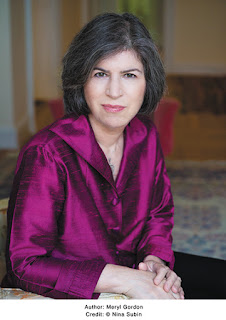Meryl Gordon is the author of the new biography Bunny Mellon: The Life of an American Style Legend. She also has written Mrs. Astor Regrets and The Phantom of Fifth Avenue. She is the director of magazine writing at NYU's Arthur L. Carter Journalism Institute, and a contributor to Vanity Fair.
Q: Why did you decide to write a biography of Bunny Mellon?
A: I had done two previous biographies of women over [age] 100
in the Social Register with gazillions of dollars. I thought I was done with
the genre.
I was asked to do a story on Bunny for Newsweek in 2011 and
she agreed to speak to me. The sweep of American history involved in her
life—it was so fascinating to relive the 1950s, 1960s, 1970s. Normally by the
time someone reaches their 80s, you’re beginning to wind down, but she had more
chapters! [It was interesting to see] how close she was to power.
Q: How did you research her long life, and did you learn
anything that especially surprised you?
A: The first year you hit your head on the wall, and then
things open up. The first year, I was talking to Bunny’s grandson and the
estate, and after the first year, they opened the archive. She saved
everything! She had saved all her first husband’s letters from World War II. I
was getting 75-year-old gossip!
There were five boxes of her friendship with Givenchy. And
her letters from [her second husband] Paul [Mellon]—they had a complicated
marriage. They led separate lives, but wrote sweet affectionate notes.
Q: What would you say is her legacy today?
A: I think she’s known primarily for her design for the Rose
Garden, which lives on. When you read about press conferences in the Rose
Garden, it’s still Bunny’s basic design. It hasn’t really changed in a dramatic
manner since 1962.
The other part is that she was ahead of her time in terms of
personal style and her taste in art. I was fascinated by the auction of her
stuff in 2014. The prices were insane, one hundred times more than what they
were valued at. I couldn’t afford any of that!
There were so many articles about her as a style guru, the
shabby chic style. My husband loved my working on this book—I was like, Let’s
fix the place up!
Q: How would you characterize her relationship with Jackie
Kennedy?
A: From everyone I spoke to, they were soulmates. Jackie
was significantly younger, yet from the minute they met in 1958, they were
incredibly close. Bunny was very discreet, and Jackie was aware of people
gossiping about her.
I was only allowed to see a small sample of their letters.
Jackie as First Lady was writing to Bunny: You hate the spotlight; I was so
afraid you’ll fade away. It was touching—it showed the vulnerability of Jackie.
They traveled the world. They shopped together. They both were obsessed with
presentation.
Q: As a very elderly woman, Bunny became involved with the
John Edwards presidential campaign, donating large amounts of money to him and eventually
becoming part of a court case. Why was she so attached to John Edwards?
A: She fell in love with his Two Americas speech. She was
taking care of her daughter, who was brain-damaged. Her life had shrunk. She
saw him as the new John Kennedy. A friend arranged an introduction, and she
felt relevant. He called her. He was a very charming, attractive man.
She never got angry about the money. She had fun with it.
She wanted to elect a progressive liberal Democrat. To his credit, he stayed in
touch with her afterwards. The final weekend before she died, one of the calls
she made was to him.
Q: You've now written biographies of Bunny Mellon, Huguette
Clark, and Brooke Astor. How would you compare the three women?
A: They had things that were very similar, and things that
were very different. Brooke Astor married her money when she married Vincent
Astor. Huguette Clark inherited money. Bunny had the good fortune to inherit
her money and also married money. She was the wealthiest of all.
All three did not go to college. Brooke and Bunny were
frustrated that they were denied opportunities in a man’s world. All three were
involved in art. All three, later in life, became victims of elder
exploitation. It shows that kind of money can make you vulnerable.
Q: What are you working on now?
A: I don’t have a next idea, but I’m ready to do something
different! After these three books, I’ve covered this area. No one has
fascinated me equally from this particular time [period].
What’s fun about the three books is the mixture of people
who knew them, and archival research. I don’t know. I’m open to ideas!
Q: Anything else we should know?
A: What interested me about Bunny was the theme of resilience.
I’m personally fascinated by what happens to people when things go wrong in
their life. Bunny was inspirational. She took pleasure from nature. When things
went wrong, she could take pleasure in what was around her, and was able to
deal with her grief and move forward.
I got in the habit of “adding a little Bunny” to my life. I
would get up from the computer and look at the sunset. It was my ode to Bunny.
It’s one of the lasting things that stayed with me.
--Interview with Deborah Kalb. Here's a previous Q&A with Meryl Gordon.




No comments:
Post a Comment